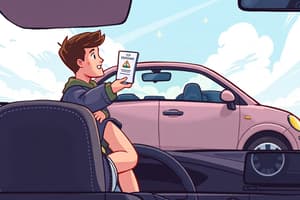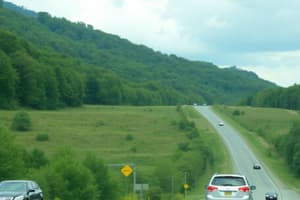Podcast
Questions and Answers
Put your hands at ___ o'clock and ____ o'clock on the steering wheel.
Put your hands at ___ o'clock and ____ o'clock on the steering wheel.
8 o'clock and 4 o'clock
What is the maximum speed limit on a non-rural interstate highway?
What is the maximum speed limit on a non-rural interstate highway?
55 MPH
What is the maximum speed limit on an interstate highway if it is in certain rural areas?
What is the maximum speed limit on an interstate highway if it is in certain rural areas?
70 MPH
What is the maximum speed limit in a school zone if the school zone light is flashing?
What is the maximum speed limit in a school zone if the school zone light is flashing?
What is the maximum speed limit in a residential zone?
What is the maximum speed limit in a residential zone?
What is the maximum speed limit in a business zone?
What is the maximum speed limit in a business zone?
What are the three factors which determine the distance it will take you to stop your vehicle?
What are the three factors which determine the distance it will take you to stop your vehicle?
What is perception time?
What is perception time?
What is reaction distance?
What is reaction distance?
What is braking distance?
What is braking distance?
What factors affect perception time, reaction distance, and braking distance?
What factors affect perception time, reaction distance, and braking distance?
What additional factors affect braking distance?
What additional factors affect braking distance?
Wet pavement can ________ your braking distance.
Wet pavement can ________ your braking distance.
Should you pump anti-lock brakes?
Should you pump anti-lock brakes?
What is the stopping distance at 25 MPH?
What is the stopping distance at 25 MPH?
What is the stopping distance at 35 MPH?
What is the stopping distance at 35 MPH?
What is the stopping distance at 45 MPH?
What is the stopping distance at 45 MPH?
What is the stopping distance at 55 MPH?
What is the stopping distance at 55 MPH?
What is the stopping distance at 65 MPH?
What is the stopping distance at 65 MPH?
If the traffic lights at an intersection are not working, what do you do?
If the traffic lights at an intersection are not working, what do you do?
How far away from a fire truck that is answering a call are you able to park?
How far away from a fire truck that is answering a call are you able to park?
How far of a distance must you keep when driving behind an emergency vehicle that is flashing its lights?
How far of a distance must you keep when driving behind an emergency vehicle that is flashing its lights?
Another word for a roundabout, traffic circle or circular intersection is a _____
Another word for a roundabout, traffic circle or circular intersection is a _____
When driving on the highway, stay in the ____ lane if you are driving slower than the traffic behind you.
When driving on the highway, stay in the ____ lane if you are driving slower than the traffic behind you.
When passing another vehicle, check the traffic ahead of you, behind you, and ____ before you attempt to pass.
When passing another vehicle, check the traffic ahead of you, behind you, and ____ before you attempt to pass.
When you are attempting to pass another vehicle, is it legal to exceed the speed limit while passing?
When you are attempting to pass another vehicle, is it legal to exceed the speed limit while passing?
When is it legal to pass on the right?
When is it legal to pass on the right?
What should you do (in terms of speed) if you are being passed by another vehicle?
What should you do (in terms of speed) if you are being passed by another vehicle?
When is it illegal to pass?
When is it illegal to pass?
What is over-correcting?
What is over-correcting?
Are most over-correction accidents single car accidents or do they involve multiple cars?
Are most over-correction accidents single car accidents or do they involve multiple cars?
How can you avoid over-correcting?
How can you avoid over-correcting?
What lane should you be in to make a right turn?
What lane should you be in to make a right turn?
How many seconds and how many feet ahead of your turn should you signal that you are turning?
How many seconds and how many feet ahead of your turn should you signal that you are turning?
Flashcards are hidden until you start studying
Study Notes
Learner's Permit Test Key Facts
- Hands should be placed at 8 o'clock and 4 o'clock on the steering wheel for proper control.
- Maximum speed limit on non-rural interstates is 55 MPH.
- In specific rural areas, the maximum speed limit on interstates increases to 70 MPH.
- The speed limit in a school zone, when lights are flashing, is 25 MPH.
- Residential and business zones also have a maximum speed limit of 25 MPH.
Stopping Distances and Factors
- Stopping distances are influenced by three factors: perception time, reaction time, and braking distance.
- Perception Time: The duration taken to recognize a hazard.
- Reaction Distance: The distance traveled while recognizing a problem and applying brakes.
- Braking Distance: The distance covered after brakes are applied.
- Perception time, reaction distance, and braking distance can be affected by weather, visibility, and the driver’s physical and mental condition.
- Additional factors such as vehicle speed, brake and tire conditions, and pavement status significantly impact braking distance.
- Wet pavement can double your braking distance.
Driving Techniques and Regulations
- Never pump anti-lock brakes; this is a crucial safety rule.
- Stopping distances vary by speed:
- 25 MPH: 85 feet
- 35 MPH: 135 feet
- 45 MPH: 195 feet
- 55 MPH: 265 feet
- 65 MPH: 344 feet
- If traffic lights at an intersection malfunction, all vehicles must stop, with the driver on the right granted the right of way.
- Vehicles must park 500 feet away from a fire truck responding to a call.
- Maintain a distance of 500 feet behind an emergency vehicle with flashing lights.
Road Features and Passing Rules
- A roundabout or traffic circle is also referred to as a "rotary."
- On the highway, drivers going slower than traffic should stay in the right lane.
- Check ahead, behind, and in blind spots before passing.
- Exceeding the speed limit while passing another vehicle is illegal.
- Passing on the right is permissible if the vehicle ahead is making a left turn.
- If overtaken by another vehicle, maintain or reduce speed.
Passing Regulations
- Passing is illegal when a solid line marks your lane or at hills, curves, or railroad crossings if only one lane exists on each side.
- Over-correcting occurs when a driver turns the steering wheel too sharply, potentially leading to loss of control.
- Most over-correcting incidents are single-vehicle accidents.
- To avoid over-correcting: stay alert, reduce speed gradually if veering off road, and steer smoothly back into your lane.
- When making a right turn, use the lane closest to the curb.
- Signal a turn 3-4 seconds or approximately 100 feet before executing the turn.
Studying That Suits You
Use AI to generate personalized quizzes and flashcards to suit your learning preferences.




